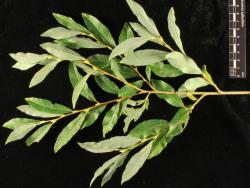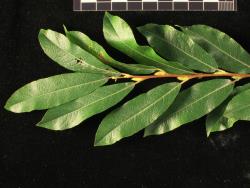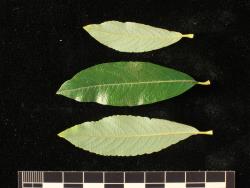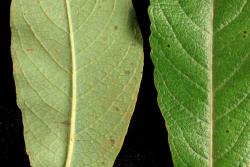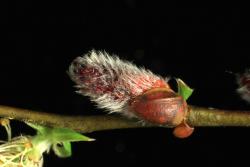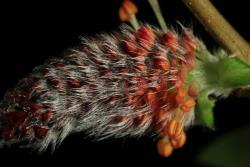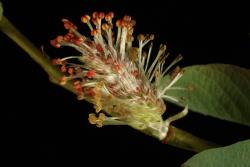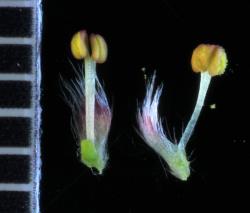- = Salix ×auritoides A.Kern., Verh. K. K. Zool.-Bot. Ges. Wien 10: 257 (1860)
Current year's branchlets yellow-green with reddish-brown tinting (UCL43), with moderately dense, appressed brown hairs mixed with a few silver hairs. Year-old branchlets light to olive-brown (UCL95), glabrous, 2.3–2.8 mm diameter. Flower bud scales 6.5–9.0 mm long, 2.7–5.0 mm wide, 2.4–3.0 mm deep, lanceolate, with 2 angles, red-brown (UCL43) to strong brown, glabrous. Leaves alternate or alternate and opposite. Stipule 3 mm long, not persisting. Petiole 7–15 mm long, moderately densely tomentose on upper surface only, adaxial groove absent, glands absent, base of petiole not expanded, pinky red. Emerging leaves green, with sparsely tomentose hairs, brown hairs sometimes present. Proximal leaves toothed. Leaf lamina 68–109 mm long, 20–34 mm wide, length to width ratio 3.2–3.4:1, narrowly obovate, not falcate; base rounded; apex acute; leaf galls absent; margins crenate, finely revolute or flat; upper lamina surface smooth to slightly bullate, medium glossy, glabrous except tomentum on midvein, stomata absent; lower lamina surface midvein and side-veins raised, indistinctly glaucous, lamina glabrous, sparsely tomentose near midvein. Catkins male or female, emergence precocious. Flowering branch 10–31 mm long with 4–5 cataphylls. Male catkin 9–15 mm long, 6–9 mm diameter; catkin rachis not visible between flowers. Female catkin 25–26 mm long, 10 mm diameter; catkin rachis not visible between flowers. Flower bract 1.9–2.2 mm long, 0.76–1.2 mm wide, initially crimson, becoming black in upper half, yellow-green in the lower half, flat; apex obtuse, densely long-silky hairy. Male nectary 1, 0.64–0.7 mm long, 0.2–0.3 mm wide, green-brown. Stamens 2, filaments fused halfway to nearly the length of the filament, hairs present at base of filament; anthers 0.5–1.0 mm long, red. Female nectary 1, 0.4 mm long, 0.14 mm wide; ovary 2.0 mm long, densely short-silky hairy; stipe 0.5 mm long; style base 0.2 mm long, style arms 0.3 mm, unlobed, pale yellow-green.
Salix ×dichroa is an S. purpurea hybrid, which has features of S. purpurea such as the single united stamen filament, a small, densely hairy ovary with a very short style and stipe, and glabrous mature leaves with few marginal teeth. Leaves resemble those of S. purpurea in being entire to distantly serrate, narrowly obovate, dull above, the lamina glaucous, but the leaves in bud are quite densely short-silky hairy; those hairs are quickly lost, and mature leaves have hairs only on the upper surface midvein near the base. Brown hairs are present on the lower leaf surface of PN680, but not on leaves of PN286. Catkins are densely silky-hairy on the outside of the catkin, and are ovoid, and with flower bracts that emerge crimson but become black, but the male catkins are smaller (9–15 mm long, not 21–36 mm long).
Similar to Salix ×rubra (S. purpurea × S. viminalis). Both hybrids can have brown leaf lamina hairs mixed with silver hairs, but S. ×rubra lacks the united stamen filament. Salix ×rubra has long style arms and a long style base in contrast to S. ×dichroa, which has a short stipe 0.5 mm long and short style arms, 0.3 mm long.
PN680 and PN286 were both accessioned into the Aokautere collection as Salix ×dichroa but differ in the presence of brown hairs. Salix aurita in the UK does not have brown hairs, but in Austria and Russia the species invariably has brown leaf hairs. There are other hybrid specimens in CHR that have brown hairs and appear to have S. purpurea as a parent. These have been variously determined as S. ×rubra (S. purpurea × S. viminalis), S. ×forbyana (S. cinerea × S. purpurea × S. viminalis). New Zealand material may also belong to S. ×ferruginea (S. atrocinerea × S. purpurea). Whereas S. purpurea is a very distinct species, and it is easy to see its presence in a hybrid, the other parent of a S. purpurea hybrid can be more difficult to determine. It is very difficult with the limited material available to decide how many hybrids involving S. purpurea there are present in New Zealand.
In cultivation at Gisborne (Waioeka Gorge 1978), Southern North Island (Aokautere 2017), Canterbury (Hororata 1981).
Present in the National Willow Collection in Palmerston North as two clones: PN286 and PN680.
First collection: CHR 368469, M. Heginbotham, February 1978, Waioeka Gorge, planted on the Waioeka River bank.
First publication: This publication.
Flowering: Mid-September–late October.
Unknown.



